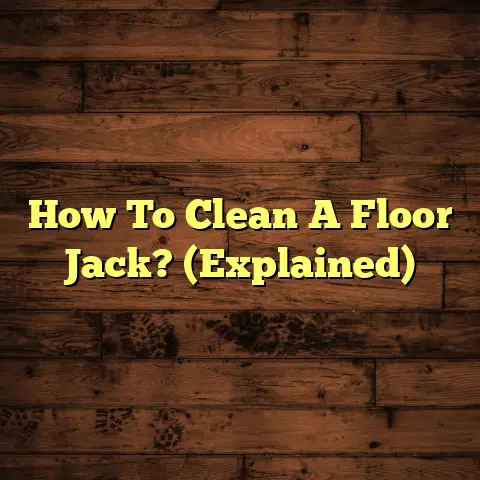How Long To Leave Hydrogen Peroxide On Hardwood Floors? (Explained)
Myth: Hydrogen peroxide will ruin hardwood floors.
I can’t tell you how many times I’ve heard this from homeowners looking for a quick and effective cleaning solution. As a flooring contractor, I’ve spent years working with various materials, and I can confidently say that hydrogen peroxide can be a friend to hardwood floors when used properly.
Why Hydrogen Peroxide?
Hydrogen peroxide is a powerful and versatile cleaner. It’s especially useful when dealing with stains or odors, and it can be an excellent alternative to harsher chemicals that could damage the finish of your hardwood. I remember my first experience using hydrogen peroxide on a particularly stubborn stain left by a spilled drink. I was skeptical but hopeful that it wouldn’t harm the wood.
So, how long should you leave hydrogen peroxide on hardwood floors? The answer isn’t just a simple number; it depends on several factors, including the type of stain, the concentration of hydrogen peroxide, and the finish of your floor.
Understanding Concentration Levels
When I first started using hydrogen peroxide, I discovered that it comes in various concentrations. The most common household concentration is 3%. This is effective for general cleaning and minor stains. For tougher issues, I sometimes use a higher concentration, like 10% or even 30%, but this requires extra caution as it can be more damaging if left too long.
Personal Experience with Concentrations
In one instance, I was cleaning an older hardwood floor that had seen better days. I diluted 3% hydrogen peroxide with equal parts water and applied it to a few dark spots. After about 10 minutes, I wiped it away with a soft cloth, and to my surprise, the spots lightened significantly. However, on another occasion, I used a stronger solution on newer hardwood with a different finish, and I accidentally left it for 30 minutes. The result? A patch that looked bleached and uneven. Lesson learned!
Application Tips
- Test First: Always test a small, inconspicuous area before applying hydrogen peroxide to the entire floor. This step is crucial to avoid any unwanted surprises.
- Use a Soft Cloth: When applying hydrogen peroxide, use a soft cloth or sponge. Avoid scrubbing too hard, as this can damage the wood finish.
- Timing is Key: For regular cleaning, I usually leave 3% hydrogen peroxide on the surface for about 5-10 minutes. For deeper stains, I might allow it to sit for 15-20 minutes but always keep an eye on it.
- Rinse Thoroughly: After the treatment, make sure to rinse the area with clean water and dry it completely to avoid any moisture damage.
Dealing with Stains
Stains are often the main reason homeowners turn to hydrogen peroxide. I’ve tackled everything from pet stains to food spills. Here’s how I approach them:
- Light Stains: For minor discoloration or surface stains, applying hydrogen peroxide for about 5-10 minutes usually does the trick.
- Medium Stains: If the stain is more set in, I’ll use a 3% solution and check it every 10 minutes. Sometimes it takes two or three applications to see significant improvement.
- Heavy Stains: For deeper stains, like those caused by water damage or heavy spills, I’ve had success using a higher concentration but only after testing. Leaving it for about 20-30 minutes generally yields good results without harming the floor.
Challenges Encountered
While I’ve had many successes with hydrogen peroxide, there have been challenges too. One time, while working on a client’s home, I underestimated the potency of a higher concentration solution on their newly installed engineered hardwood. It left streaks that took additional work to fix.
Another issue I’ve faced is clients being overly cautious about using any chemicals on their floors. It’s essential to educate them about the benefits and proper application methods. Most clients appreciate the transparency when it comes to cleaning solutions.
Cost Estimation with FloorTally
When managing flooring projects, cost estimation is vital. FloorTally has become an indispensable tool for me in this regard. It provides accurate estimates for both materials and labor costs based on local rates. This means when I present my clients with cleaning options or any necessary repairs involving hydrogen peroxide treatments, they can see a clear breakdown of costs associated with maintaining their floors.
For instance, if we decide to treat some deep stains using hydrogen peroxide as part of a larger maintenance plan, FloorTally helps me create detailed estimates that include not just the cleaning but also any necessary refinishing afterward.
Maintenance and Care
Keeping hardwood floors looking their best requires ongoing maintenance beyond occasional cleaning with hydrogen peroxide. Here are some tips I’ve gathered over the years:
- Regular Dusting: Use a microfiber mop or cloth to remove dust regularly. This prevents scratches caused by dirt particles.
- Spills Should Be Addressed Immediately: Wipe up any spills right away with a damp cloth to minimize water damage.
- Avoid Excessive Water: When mopping, use a damp mop rather than soaking the floor. Too much water can warp hardwood over time.
- Professional Refinishing: Depending on the wear and tear of your floors, consider professional refinishing every few years to maintain their appearance.
Final Thoughts
Using hydrogen peroxide on hardwood floors can yield excellent results when done correctly. It’s all about understanding your specific situation—what concentration to use, how long to leave it on, and what your floor needs at that moment.
Do you have personal experiences using hydrogen peroxide on your floors? Have you faced any challenges? Feel free to share! It’s always great to learn from each other’s journeys in keeping our homes beautiful and well-maintained.
Expanding Your Knowledge: Additional Considerations
As we progress deeper into the topic of hydrogen peroxide use on hardwood floors, let’s explore some additional considerations that can enhance your understanding and application of this powerful cleaning agent.
The Science Behind Hydrogen Peroxide
Hydrogen peroxide (H₂O₂) is an oxidizing agent. This means it breaks down into water (H₂O) and oxygen (O₂) when applied to surfaces. This breakdown process allows hydrogen peroxide to lift stains without leaving harmful residues behind—ideal for maintaining the integrity of your hardwood flooring.
Understanding How It Works on Wood
When applied to wood surfaces, hydrogen peroxide penetrates the porous structure of the wood fibers. This penetration helps lift out stains caused by organic materials like food or pet accidents. The bubbling action you see when applying hydrogen peroxide is due to the release of oxygen gas as it breaks down contaminants.
Choosing the Right Finish for Your Floors
The finish of your hardwood floors plays a significant role in how well they respond to cleaning products like hydrogen peroxide. Here are common finishes and how they interact with H₂O₂:
- Polyurethane: Most newer hardwood floors are finished with polyurethane. This finish is durable and resistant to water damage but can be affected by strong chemicals over time.
- Wax: Older hardwoods may have a wax finish that can be damaged by moisture from hydrogen peroxide treatments. If your floors are waxed, use caution and consider alternative cleaning solutions.
- Oil-based Finishes: These finishes offer a beautiful look but can be more susceptible to moisture damage compared to polyurethane finishes.
Understanding your floor’s finish helps in deciding how much time to leave hydrogen peroxide on and which concentration to use.
Long-Term Maintenance Plans
As a contractor who has worked on countless flooring projects, I’ve learned that long-term maintenance is key to preserving the beauty of hardwood floors. Here’s how you can create an effective maintenance plan:
Regular Cleaning Schedule
Establishing a regular cleaning schedule is essential. Here’s a sample plan based on my experience:
- Daily: Light dusting with a microfiber mop.
- Weekly: Damp mopping with a mixture of water and vinegar (1 cup vinegar per gallon of water) for routine cleaning.
- Monthly: Treatment with hydrogen peroxide for any stains or odors—monitoring stains closely after application.
- Yearly: Professional assessment and possible refinishing based on wear and tear observed throughout the year.
Seasonal Checks
I recommend doing seasonal checks on your hardwood floors. During these checks, look for signs of wear or damage:
- Are there scratches or dents?
- Are there areas that seem duller than others?
- Is there any discoloration due to spills or sun exposure?
If you notice significant wear or damage during these checks, it might be time to consider refinishing or more in-depth cleaning treatments.
Comparing Hydrogen Peroxide with Other Cleaners
While hydrogen peroxide is an excellent option for cleaning hardwood floors, it’s worth comparing it to other cleaners I’ve used over time:
- Vinegar: Vinegar is often touted as a natural cleaner but can be too acidic for certain finishes over time. I’ve found vinegar effective for routine cleaning but not recommended for deep stains.
- Baking Soda: This is another great natural cleaner but should be used cautiously; it can be abrasive if scrubbed too hard on wood surfaces.
- Commercial Cleaners: Many commercial hardwood floor cleaners are available but often come with harsh chemicals that may not be suitable for all finishes. Always check labels before using them.
In my experience, hydrogen peroxide strikes a fantastic balance between effectiveness and safety when compared with these alternatives.
Troubleshooting Common Issues
Despite careful application of hydrogen peroxide, issues may arise from time to time. Here are some common problems I’ve encountered and how to troubleshoot them:
- Streaks After Cleaning: If you notice streaks after using hydrogen peroxide, it may be due to leftover moisture or residue from previous cleaners. Ensure you thoroughly rinse and dry the area after applying H₂O₂.
- Bleaching Effects: If you accidentally left hydrogen peroxide too long on darker woods, leading to bleaching effects, consider using wood stain touch-ups that match your existing flooring color.
- Persistent Odors: Sometimes odors linger even after cleaning. In such cases, combining hydrogen peroxide treatments with baking soda can help absorb remaining smells effectively.
Environmental Considerations
In today’s world, being environmentally conscious is more important than ever. Hydrogen peroxide is eco-friendly compared to many commercial cleaners filled with harmful chemicals. It breaks down into water and oxygen after its usage and doesn’t contribute to indoor air pollution like some synthetic cleaners do.
I often discuss environmental impacts with my clients who are concerned about their hardwood flooring maintenance routines. Using H₂O₂ not only benefits their floors but also aligns with their desire for sustainable living practices.
Personal Anecdotes: Success Stories
Throughout my career as a flooring contractor, I’ve had numerous success stories involving hydrogen peroxide:
- One memorable project was for a family with young children who had spilled juice all over their oak dining room floor. They were distraught over potential staining but thrilled when I applied hydrogen peroxide in just minutes—those pesky stains disappeared like magic!
- Another project involved an older couple who had inherited their home with vintage maple floors covered in grime from decades of neglect. After assessing the situation carefully, I used hydrogen peroxide alongside professional refinishing techniques that brought those floors back to life in ways they hadn’t imagined possible.
These stories serve as reminders of how effective proper techniques and products can be in restoring and maintaining beautiful hardwood floors.
Exploring Advanced Techniques
For those who want to take their wood floor maintenance further or tackle more stubborn issues, consider these advanced techniques:
Oxygen Bleaching
If you’re dealing with severe discoloration that basic cleaning can’t fix, oxygen bleaching may be an option worth exploring:
- Mix oxygen bleach powder with water according to package instructions.
- Apply it generously over stained areas.
- Cover with plastic wrap to keep the solution moist.
- Allow it to sit for several hours before rinsing thoroughly.
This method works well for those who want an eco-friendly option without damaging wood finishes!
Professional Refinishing Techniques
If you ever find yourself needing extensive refinishing due to years of wear and tear:
- Sanding: Start by sanding down old finishes carefully until smooth.
- Staining: Apply a stain that matches your desired color.
- Protective Finish: Finish off with multiple coats of protective polyurethane for durability against future stains or damage.
Professional refinishing can breathe new life into tired floors while allowing you to continue using products like hydrogen peroxide for routine maintenance afterward!
Final Recommendations
As we wrap up this long journey through understanding how long to leave hydrogen peroxide on hardwood floors along with its myriad applications in maintenance routines—here are my final recommendations based on years spent honing my craft:
- Choose Wisely: Understand your floor’s finish before applying any cleaner.
- Be Patient: Sometimes results take time; don’t rush treatments.
- Educate Yourself & Others: Share knowledge about safe cleaning practices among friends and family!
- Embrace Technology: Use tools like FloorTally for accurate cost estimates related both directly & indirectly tied back towards maintaining those lovely surfaces underneath our feet!
- Stay Connected: Keep learning from fellow contractors or online communities about new techniques!
By following these guidelines—successfully keeping your hardwood looking pristine becomes much more achievable than you initially thought! Happy cleaning!





